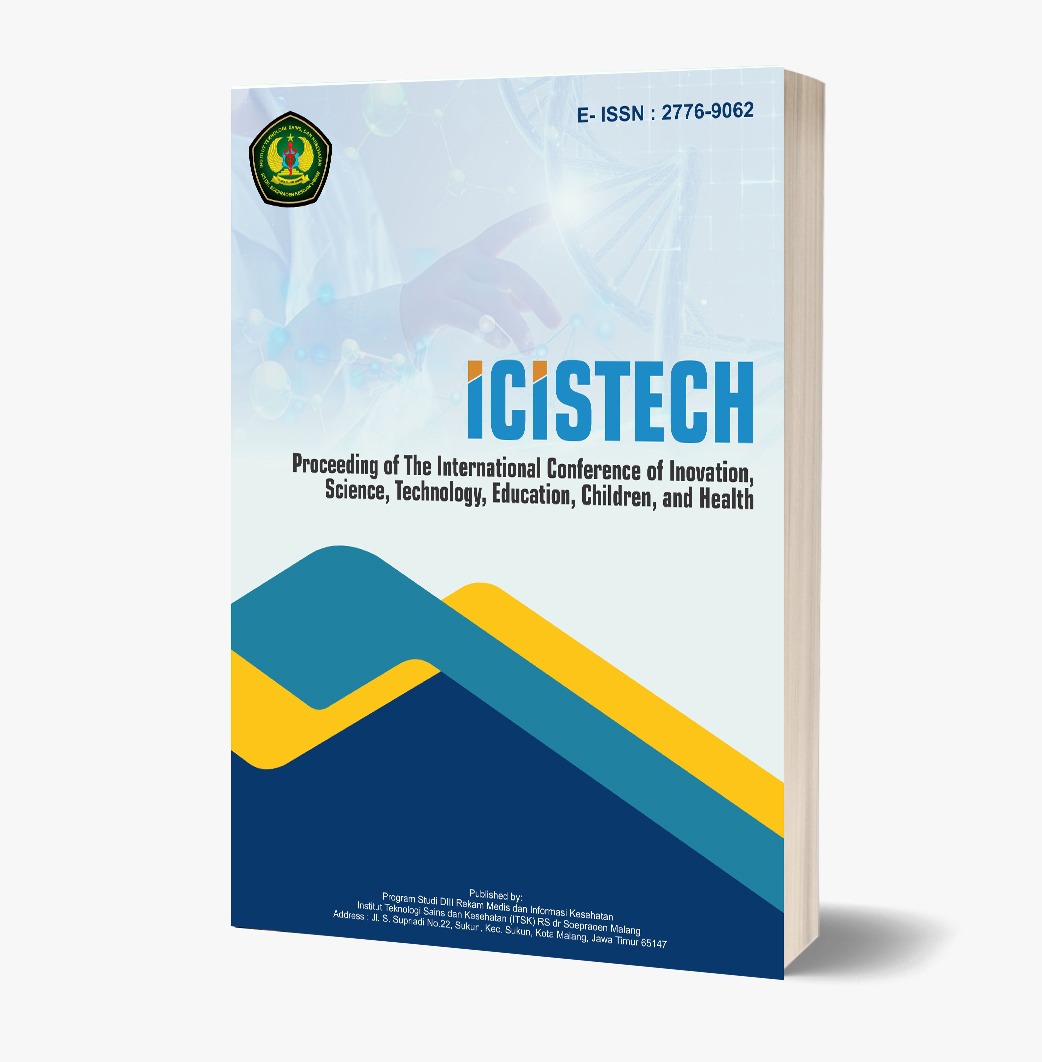The Connection between Pregnancy Spacing and the Occurrence of Stunting in Children : An In-Depth Analysis of Contributing Factors
DOI:
https://doi.org/10.62951/icistech.v5i1.222Keywords:
Parity, Pregnancy spacing, StuntingAbstract
Stunting is a serious nutritional problem in Indonesia, affecting the growth and development of children under five years of age. Non-ideal pregnancy spacing is one of the factors that can contribute to stunting, as closely spaced pregnancies can lead to inadequate maternal nutrition, which affects the child’s development. This study aims to analyze the relationship between pregnancy spacing and the incidence of stunting in children under five. The research design employed is observational analytic with a case-control approach. Data collection was conducted from February to October 2024, focusing on children with stunting and children with normal growth as control cases. The case-control study involved a total sample size of 60 children, with 30 stunted children as cases and 30 non-stunted children as controls. The control cases were selected using simple random sampling to ensure unbiased representation. The primary analysis technique used was the chi-square test to examine the relationship between pregnancy spacing and the incidence of stunting. The results indicated that children born with a pregnancy spacing of less than 24 months had a 1.5 times higher risk of experiencing stunting compared to those born with a pregnancy spacing of more than 24 months. Statistical analysis using the chi-square test yielded a significant p-value of 0.002 (< 0.05), which confirms a strong association between short pregnancy spacing and stunting. This study concludes that insufficient pregnancy spacing is a significant factor contributing to the incidence of stunting in children under five. Therefore, it is recommended that public health campaigns and education programs on family planning and reproductive health be strengthened to reduce the risk of stunting in Indonesia. Such initiatives will help prevent future generations from experiencing the negative effects of inadequate growth and development.
References
Abdillah, S. (2022). The effect of maternal and child factors on stunting in children under five years in rural Indonesia. KnE Life Sciences, 2022, 813-822. https://doi.org/10.18502/KLS.V7I2.10382
Beal, T., Tumilowicz, A., Sutrisna, A., Izwardy, D., & Neufeld, L. M. (2018). A review of child stunting determinants in Indonesia. Maternal & Child Nutrition, 14(4), e12617. https://doi.org/10.1111/mcn.12617
Bharti, R., Dhillon, P., & Narzary, P. K. (2019). A spatial analysis of childhood stunting and its contextual correlates in India. Clinical Epidemiology and Global Health, 7(3), 488–495. https://doi.org/10.1016/j.cegh.2019.04.005
Charla, E., Bingan, S., Kebidanan, J., Kemenkes, P., & Raya, P. (2019). Hubungan konsumsi Fe dengan panjang badan pada anak usia 12–24 bulan. Media Informasi, 15(2), 115–120. https://doi.org/10.37160/bmi.v15i2.415
Christian, P., Lee, S. E., Angel, M. D., Adair, L. S., Arifeen, S. E., Ashorn, P., Barros, F. C., Fall, C. H. D., Fawzi, W. W., Hao, W., Hu, G., Humphrey, J. H., Huybregts, L., Joglekar, C. V., Kariuki, S. K., Kolsteren, P., Krishnaveni, G. V., Liu, E., Martorell, R., … Black, R. E. (2013). Risk of childhood undernutrition related to small-for-gestational age and preterm birth in low- and middle-income countries. International Journal of Epidemiology, 42(5), 1340–1355. https://doi.org/10.1093/IJE/DYT109
Dewi, R., Evrianasari, N., & Yuviska, I. A. (2020). Kadar Hb, Lila dan berat badan ibu saat hamil berisiko terhadap kejadian stunting pada anak usia 1–3 tahun. Jurnal Kebidanan Malahayati, 6(1), 57–64. https://doi.org/10.33024/jkm.v6i1.1769
Gupta, A. K., & Santhya, K. G. (2020). Proximal and contextual correlates of childhood stunting in India: A geo-spatial analysis. PLOS ONE, 15(8). https://doi.org/10.1371/journal.pone.0237661
J, T., A, S., R, Z., MZ, Z., & F, F. (2018). Factors associated with undernutrition in children under the age of two years: Secondary data analysis based on the Pakistan Demographic and Health Survey 2012−2013. Nutrients, 10(6). https://doi.org/10.3390/NU10060676
Kemenkes. (2022). Buku saku hasil studi status gizi Indonesia (SSGI) tahun 2021 | Badan Penelitian dan Pengembangan Kesehatan. https://www.litbang.kemkes.go.id/buku-saku-hasil-studi-status-gizi-indonesia-ssgi-tahun-2021/
Maulina, R., Qomaruddin, M. B., Prasetyo, B., & Indawati, R. (2024). Maternal complications during pregnancy and risk factors for stunting. Iranian Journal of Nursing and Midwifery Research, 29(3), 309–313. https://doi.org/10.4103/IJNMR.IJNMR_358_22
Maulina, R., Qomaruddin, M. B., Sumarmi, S., Fahrul, A., & Haryuni, S. (2022). Antenatal depression as a stunting risk factor: A systematic review. Open Access Macedonian Journal of Medical Sciences, 10(F), 234–240. https://doi.org/10.3889/oamjms.2022.8501
McDonald, C. M., Manji, K. P., Kisenge, R., Aboud, S., Spiegelman, D., Fawzi, W. W., & Duggan, C. P. (2015). Daily zinc but not multivitamin supplementation reduces diarrhea and upper respiratory infections in Tanzanian infants: A randomized, double-blind, placebo-controlled clinical trial. The Journal of Nutrition, 145(9), 2153–2160. https://doi.org/10.3945/JN.115.212308
Mireku, M. O., Cot, M., Massougbodji, A., & Bodeau-Livinec, F. (2020). Relationship between stunting, wasting, underweight and geophagy and cognitive function of children. Journal of Tropical Pediatrics, 66(5), 517–527. https://doi.org/10.1093/TROPEJ/FMAA009
Nita Retnasari. (2011). Faktor-faktor yang mempengaruhi perilaku ibu dalam deteksi dini tumbuh kembang pada balita di Posyandu Pudaksari Poncosari Srandakan Bantul. STIKES Aisyah Yogyakarta.
Nur Apriningtyas, V., Dewi Kristini, T., Epidemiologi Fakultas Kesehatan Masyarakat Universitas Muhammadiyah Semarang, D., & Kesehatan Provinsi Jawa Tengah, D. (2019). Faktor prenatal yang berhubungan dengan kejadian stunting anak usia 6–24 bulan. Jurnal Kesehatan Masyarakat Indonesia, 14(2), 13–17. https://doi.org/10.26714/JKMI.14.2.2019.13-17
O, N., B, K., & EJ, W. (2019). Maternal employment and child nutritional status in Uganda. PLOS ONE, 14(12). https://doi.org/10.1371/JOURNAL.PONE.0226720
Puspitaningrum, T. K., Rambert, G. I., & Wowor, M. F. (2016). Gambaran kadar feritin pada pasien penyakit ginjal kronik stadium 5 non dialisis. Jurnal E-Biomedik (EBm), 4(1). https://doi.org/10.35790/ebm.4.1.2016.12486
Rahmawati, V. E., Pamungkasari, E. P., & Murti, B. (2018). Determinants of stunting and child development in Jombang District. Journal of Maternal and Child Health, 03(01), 68–80. https://doi.org/10.26911/thejmch.2018.03.01.07
Suchdev, P. S., Jefferds, M. E. D., Ota, E., da Silva Lopes, K., & De-Regil, L. M. (2020). Home fortification of foods with multiple micronutrient powders for health and nutrition in children under two years of age. Cochrane Database of Systematic Reviews, 2020(2). https://doi.org/10.1002/14651858.CD008959.PUB3
Titaley, C. R., Ariawan, I., Hapsari, D., & Muasyaroh, A. (2019). Determinants of the stunting of children in Indonesia: A multilevel analysis of the 2013 Indonesia Basic Health Survey. Nutrients, 11, 1160. https://doi.org/10.3390/nu11051106
Trihono, A. (2015). Pendek (stunting) di Indonesia, masalah dan solusinya. Balitbangkes.
Udoh, E. E., & Amodu, O. K. (2016). Complementary feeding practices among mothers and nutritional status of infants in Akpabuyo Area, Cross River State, Nigeria. SpringerPlus, 5(1). https://doi.org/10.1186/S40064-016-3751-7/TABLES/8
WHO. (2018). Reducing stunting in children, equity considerations for achieving the global nutrition targets 2025.
Yunitasari, E., Winasis, P., & Suarilah, I. (2020). The analysis of stunting event factors in children aged 24–59 months based on transcultural nursing. EurAsian Journal of BioSciences, Eurasia J Biosci, 14, 2715–2720.
Zhang, L., Kleiman-Weiner, M., Luo, R., Shi, Y., Martorell, R., Medina, A., & Rozelle, S. (2013). Multiple micronutrient supplementation reduces anemia and anxiety in rural China's elementary school children. The Journal of Nutrition, 143(5), 640–647. https://doi.org/10.3945/JN.112.171959
Downloads
Published
How to Cite
Issue
Section
License
Copyright (c) 2025 Proceeding of The International Conference of Inovation, Science, Technology, Education, Children, and Health

This work is licensed under a Creative Commons Attribution-ShareAlike 4.0 International License.













